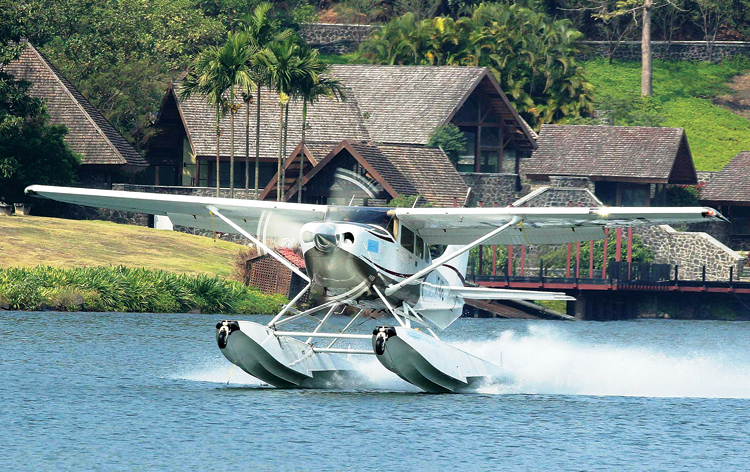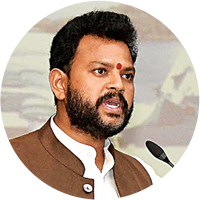INDIAN ARMED FORCES CHIEFS ON OUR RELENTLESS AND FOCUSED PUBLISHING EFFORTS

The insightful articles, inspiring narrations and analytical perspectives presented by the Editorial Team, establish an alluring connect with the reader. My compliments and best wishes to SP Guide Publications.

"Over the past 60 years, the growth of SP Guide Publications has mirrored the rising stature of Indian Navy. Its well-researched and informative magazines on Defence and Aerospace sector have served to shape an educated opinion of our military personnel, policy makers and the public alike. I wish SP's Publication team continued success, fair winds and following seas in all future endeavour!"

Since, its inception in 1964, SP Guide Publications has consistently demonstrated commitment to high-quality journalism in the aerospace and defence sectors, earning a well-deserved reputation as Asia's largest media house in this domain. I wish SP Guide Publications continued success in its pursuit of excellence.
A Boost for Connectivity and Economic Growth
The recently launched India’s guidelines for Seaplane Operations simplify certification for non-scheduled entities to operate under the UDAN scheme, eliminating the need for a water drome license and reducing compliance requirements for easier seaplane operations

In a significant move aimed at bolstering regional connectivity and unlocking new opportunities for economic growth, Union Minister for Civil Aviation, Kinjarapu Rammohan Naidu, recently launched India’s Guidelines for Seaplane Operations in New Delhi. Speaking at the Indian Aviation Academy, the Minister underscored the transformative potential of seaplanes in India’s aviation landscape, highlighting their role in creating jobs and fostering inclusive development.
“These guidelines not only integrate seaplane operations into India’s aviation network but also symbolise the country’s growth, innovation, and commitment to inclusive development,” said Naidu. He emphasised that seaplanes, by connecting remote areas, are poised to become a critical component of India’s vision for a more connected and equitable nation.
Seaplane routes have been awarded to Selected Airline Operators (SAOs) in different States/ UTs under RCS-UDAN scheme. To conduct scheduled flights under RCS-UDAN, it is mandatory as per the requirement for operators to operate flights either under Scheduled Operator or Scheduled Commuter Operator (SCO) permit and such flights could be undertaken only from licensed water aerodromes. “The SAO shall operate multi/single engine seaplanes, duly certified/accepted by DGCA in accordance with the Type Certificate issued by FAA/EASA or other authorities acceptable to DGCA and under conditions, if any, as stipulated by DGCA,” the guidelines state.
The new guidelines for seaplane operations introduce a simplified certification process, allowing non-scheduled entities to operate under the regional air connectivity scheme, UDAN. The relaxed norms by the Directorate General of Civil Aviation (DGCA) eliminate the need for a water drome license and reduce compliance requirements, facilitating easier takeoffs and landings on water.

Additionally, fresh Commercial Pilot License (CPL) holders can now directly obtain seaplane ratings, enabling them to operate these aircraft. These guidelines prioritise safety and efficiency while clarifying the responsibilities of all stakeholders. The adoption of the Non-Scheduled Operator Permit (NSOP) framework for seaplanes marks a key step in the government’s effort to boost regional connectivity. In June, the DGCA revised infrastructure procedures and pilot training requirements to further streamline seaplane operations, making it easier to reach remote areas.
In addition to unveiling the seaplane guidelines, Minister Naidu also launched the latest version of the UDAN (Ude Desh Ka Aam Nagrik) scheme—UDAN 5.4. Under this iteration, fresh bids will be invited to reopen unserved routes that were previously canceled. This is a part of India’s ongoing efforts to enhance regional connectivity under the Regional Connectivity Scheme (RCS).
As a testament to India’s commitment to advancing seaplane operations, the Minister also announced upcoming demonstration flights of seaplanes manufactured by DeHavilland, a prominent aircraft manufacturer.
The Minister’s focus on India’s unique geographical features played a key role in shaping the seaplane guidelines. “With a 7,517 km long coastline and an extensive network of rivers and lakes, India has a tremendous opportunity for the development of seaplane operations,” said Naidu. He pointed out that the Government’s experience with helicopter operations under the RCS scheme had informed a flexible, pragmatic approach to the development of seaplane infrastructure.
SEAPLANE OPERATIONS: A NEW ERA FOR INDIAN AVIATION
The newly launched Seaplane Non-Scheduled Operator Permit (NSOP) Guidelines provide a detailed framework for integrating seaplane operations into India’s aviation ecosystem. By extending the Viability Gap Funding (VGF) under RCS to seaplanes, the Government aims to provide a critical initial boost for operators, ensuring their economic sustainability.
“While promoting seaplane operations, we have taken due care to ensure safety and security,” the Minister emphasised. He explained that despite challenges, particularly in developing water aerodromes, the Government is committed to supporting seaplane growth. Drawing on the success of NSOP operations for helicopters and small aircraft, the guidelines prioritise a safe and seamless approach to seaplane operations across the country.
The adoption of the NSOP framework for seaplanes, similar to its success in helicopters, is a major step forward in India’s efforts to enhance regional connectivity. The guidelines define clear roles and responsibilities for all stakeholders, from operators to regulatory bodies, ensuring that the industry operates efficiently and safely.
A FAVOURABLE POLICY ENVIRONMENT FOR SEAPLANE GROWTH
During his address, Minister Naidu stressed the need for a policy environment that supports innovation in the seaplane sector. “We must encourage research into technologies like electric seaplanes to reduce carbon emissions, aligning with India’s climate commitments under the UN Framework on Climate Change,” he stated. The Minister also highlighted the Government’s focus on local workforce development, aiming to create jobs for pilots, maintenance staff, and ground crews.
“These guidelines not only integrate seaplane operations into India’s aviation network but also symbolise the country’s growth, innovation, and commitment to inclusive development”
—Kinjarapu Rammohan Naidu, Union Minister for Civil Aviation
“Our goal is to foster a regulatory framework that promotes growth and innovation while generating employment. We envision developing Multimodal Transport Hubs for seamless connectivity between seaplanes and other forms of transport,” said Naidu. This vision signals the potential for seaplanes to become an integral part of India’s future transportation ecosystem, improving not only connectivity but also tourism and trade.
EXPANDING ECONOMIC HORIZONS WITH SEAPLANE CONNECTIVITY
Union Minister of State for Civil Aviation, Murlidhar Mohol, added that this initiative would not only improve connectivity but also boost tourism and economic growth in remote areas. “The newly launched guidelines are designed to ensure that seaplane operations are conducted safely and efficiently, marking a new era in India’s aviation landscape,” he said.
The focus on seaplanes is expected to breathe new life into India’s tourism industry by opening up some of the country’s most remote and inaccessible regions. With the proper infrastructure and regulatory framework in place, seaplanes are set to play a key role in connecting these areas to larger economic hubs, facilitating trade, tourism, and regional development.
THE PATH AHEAD
However, Seaplane operations in India are not without challenges. Earlier government efforts to connect 10 waterdromes across the country under the regional connectivity scheme had limited success. Attempts to launch seaplane services in states like Gujarat and the Andaman Islands faced setbacks due to economic challenges and the impact of the COVID-19 pandemic. Similar initiatives were planned under the Centre’s UDAN scheme to introduce seaplane connectivity across lakes, dams, inland waterways, and coastal areas. One notable seaplane service saw Prime Minister Narendra Modi flying from the Sabarmati riverfront to the Statue of Unity. However, the service, operated by SpiceJet, was discontinued due to pandemicrelated economic difficulties. However, Naidu is optimistic about the potential for growth under the new guidelines, which have been designed with flexibility and scalability in mind.
Union Civil Aviation Secretary, Vumlunmang Vualnam, reinforced the Ministry’s proactive approach to fostering the seaplane sector. “We have decided to leverage the NSOP framework, which has already proven successful for helicopters and small aircraft under the RCS scheme. The Seaplane NSOP Guidelines will provide a structured and safe framework for seaplane operations, even as we work towards the full development of water aerodrome infrastructure,” said Vualnam.
Several companies, including SpiceJet, Maritime Energy Heli Air Services Private Ltd (Mehair), and Heritage Aviation, have reportedly expressed interest in entering India’s seaplane sector. International manufacturers like De Havilland Aircraft and Cessna are also expected to explore opportunities in this space. Currently, seaplanes imported for non-scheduled operator permit (NSOP) operations are subject to a duty of less than five per cent. State governments such as Maharashtra, Gujarat, and Andhra Pradesh are eager to establish seaplane connectivity, particularly for coastal and island regions. Sources noted, “Island chains stand to benefit greatly from dedicated seaplane operations.” However, while the sector’s potential is recognised, current aviation guidelines, designed for major airports and airlines, don’t fully address the unique needs of seaplane operators.
However, this guidelines come bearing a ray of positivity. The event, held at the Indian Aviation Academy, saw participation from key stakeholders, including the Director General of Civil Aviation, Vikram Dev Dutt, senior officials from the Ministry of Civil Aviation, representatives from State and Union Territory Governments, NSOP operators and seaplane manufacturers.
The launch of the Seaplane Guidelines and the 5.4 version of the UDAN scheme marks a significant step forward in India’s aviation journey. With a focus on sustainability, innovation, and job creation, India is positioning itself at the forefront of regional aviation growth. By promoting seaplane operations and creating a favorable environment for their success, the Government is unlocking new opportunities for connectivity, tourism, and economic empowerment, solidifying seaplanes as symbols of India’s future growth and development.






